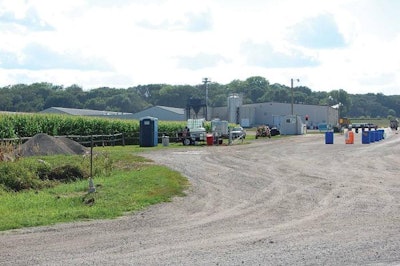
The highly pathogenic avian influenza (HPAI) outbreak in the United States forced poultry producers to seriously reevaluate their on-farm biosecurity processes and plans, according to a veterinarian who was on the front line of the crisis.
As part of a seminar on biosecurity at the International Production & Processing Expo on January 30 in Atlanta, Dr. Ben Wileman, director of veterinary and avian sciences for Select Genetics, spoke about what he learned from his experience combating and coping with the costly disease in the turkey industry.
Wileman shared critical questions for growers and integrators based on the 14 biosecurity procedures in the National Poultry Improvement Plan:
1. Biosecurity responsibility: Are you taking responsibility for biosecurity? During the 2014-2015 outbreak, Wileman said the tendency was that people did not take up the charge of a biosecurity plan, instead leaving the responsibility to officials responding to the crisis. Now, growers need to make a plan and be responsible for it.
2. Training: Are you training your staff on your biosecurity plan and are you documenting it? Wileman said he’s not a fan of excessive paperwork, but the biosecurity plan will not be effective if the staff is not trained to follow it.
3. Line of separation: Is your line of separation secure? Poultry diseases can travel in the house on workers, so a real, physical barrier is needed to create a line of separation and ensure clean and dirty areas are actually separated. A line of tape on the ground will not work. A three-stage, anteroom setup is best, but something as simple as a bench is effective.
4. Perimeter buffer area: Do you have an effective perimeter buffer area? Along the same line of thinking, farmers need to establish a buffer area to limit transmission of the disease. In the past, farmers believed they had a safe, clean perimeter if they drew an imaginary line around the farm. The HPAI outbreak reinforced that this is not an effective strategy. The line of separation between clean and dirty areas should be drawn around the poultry houses and it should be an actual, secure barrier. Furthermore, a secure buffer area needs to be established around the farm itself to limit the risk of disease transmission.
5. Personnel: What does a person need to do and wear when entering the barn and crossing the line of separation? Again, employees need to be trained in proper procedure to ensure the line of separation is effective and preventing the spread of disease.
6. Wild birds, rodents and insects: What is your rodent and pest control program? Wileman said farmers need to ask themselves how they are defending their farms from these disease vectors. A plan should be created to ensure the bait stations are being properly checked at least every 48 hours. If they are not properly monitored, they are not effective.
7. Equipment and vehicles: What vehicles are allowed to cross the perimeter buffer area? What do they have to do before entering and leaving? How do you enter and leave? Disease can travel on the farm through vehicles, so some form of barrier must be established. Beyond truck washes and vehicle controls, farmers need to consider what kind of barriers to entry they have on their farm to keep unwanted visitors out. A fence or gate isn’t needed, something as simple as a rope or chain with a no trespassing sign can create a legally effective barrier to entry.
8. Mortality disposal: What do you do with your mortality each day? Wileman said mortality disposal needs to be considered as part of disease control. Staff must be trained on an established mortality disposal procedure. Everything should be disposed of so that disease is not spread further, and it must not violate the sanctity of clean areas.
9. Manure and litter management: What do you do with your manure or litter? Ensure litter and manure is being disposed of in accordance with local laws. In addition, inform others in the areas about the litter disposal process and what diseases it could possibly contain.
10. Replacement poultry: Where do you get your replacement poultry from? Ensure that flocks supplying replacement poultry are disease free.
11. Water supplies: Is your water from surface water? If not, is action needed? While this only affects a few regions, monitor water sources to avoid contamination from wild birds and possible disease vectors.
12. Feed and replacement litter: How do you get your litter and feed delivered? How do you get into the barn? Wileman said the source of feed and litter is becoming a more important issue as farmers look to reduce their exposure to Salmonella. Furthermore, procedures reducing the risk of possible disease exposure from delivery vehicles need to be established.
13. Reporting of elevated morbidity and mortality: What is the number of birds per day that have to be ill or dead before you call someone? Who are you calling? Mortality can skyrocket inside of three days after exposure to HPAI, which begs the question of how soon farmers are reacting to elevated mortality events. Train farm workers and farm managers to recognize elevated mortality and create a mortality threshold for an elevated response.
14. Auditing: Are you self auditing? Farm managers should be able to fill out a one-page, self-performed audit report spelling out key points in the biosecurity plan like the lines of separation and buffer areas as well as the crisis response plan.
















